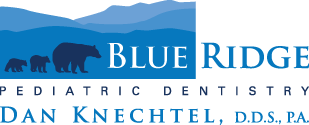
Blue Ridge Pediatric Dentistry Services:
Age 1 Dental Visit
The American Academy of Pediatrics, the American Academy of Pediatric Dentistry and the American Dental Association all recommend that your child visit the dentist by age 1. This visit will establish a dental home for your child. Early examination and preventive care will protect your child’s smile now and in the future. The most important reason to have an age one dental visit is to begin a thorough prevention program. Dental problems can begin early. A big concern is Early Childhood Caries (formerly known as baby bottle tooth decay or nursing caries). Once a child’s teeth erupt they are at risk for decay. The earlier the dental visit, the better the chance of preventing dental problems. Children with healthy teeth chew food easily and smile with confidence. Start your child now on a lifetime of good dental habits.Preventive Dentistry
Building upon the age 1 dental visit, routine prophylaxis (dental cleaning) are scheduled. The most common interval for reexamination is 6 months; however some patients may require examination and preventive services at more frequent intervals based upon historical, clinical, and radiographic findings. Preventive dentistry means a healthy smile.Preventive dental care for children includes:
- Proper nutrition and dietary habits
- Brushing and flossing
- Fluoride
- Regular dental check-ups
- Assessing risk for developing cavities
- Evaluating oral growth and development
- Oral health education
- Protection against injuries
- Management of oral habits
- Guidance of erupting teeth
- Sealants
Preventive dentistry for children, in addition to regular dental visits, requires parental involvement with daily oral care at home.
Restorative Dentistry
Should your child have dental caries (a cavity), a treatment plan will be discussed with you. Some of our restorative services include: resin (white) fillings, resin (white) and silver crowns, nerve therapy, extractions and space-maintainers.Behavior Guidance
Every child is different and each requires the appropriate behavior guidance techniques tailored to fit their needs and the desired treatments. In addition to communication and positive reinforcement, additional techniques are sometimes needed.Some of the additional techniques used are:
- Nitrous oxide (laughing gas) sedation
- Moderate (conscious) sedation often accomplished by oral medicine
- Treatment under General Anesthesia
